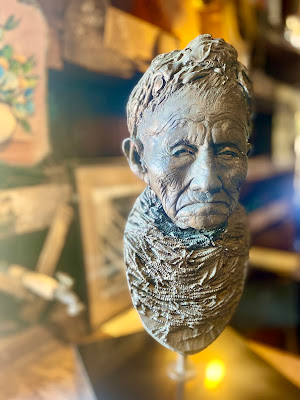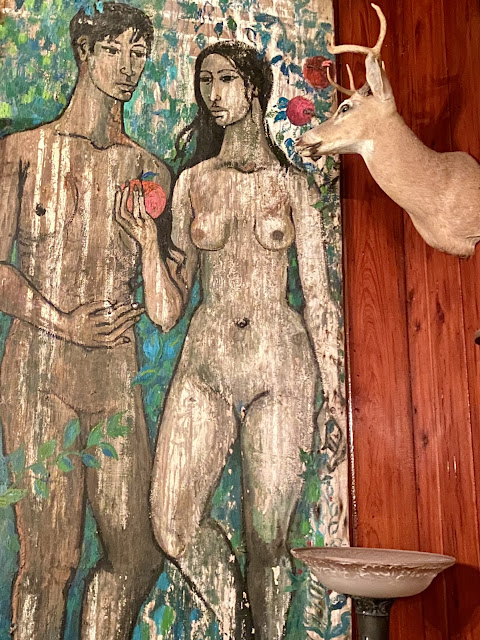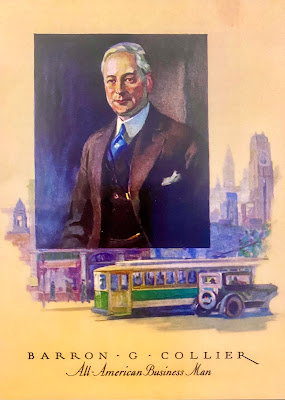Everglades City, 45 minutes southeast of Naples, gives you a taste of what I like to think of as the "reel" Florida, the state where my grandfather retired to fish in the mid 1950s. No high rise condos or traffic jams or Tesla superchargers here, although an incongruous gorilla sculpture did greet us at a non-branded fast food A-frame.
A woman I met in Delnor Wiggins Pass State Park recommended that we dine at the historic Rod & Gun Club. The name made Chris and Thom doubt our welcome, but when in Rome do as Romans, I cajoled. Folks live in this neck of the woods--which consistently floods during hurricanes--to fish and hunt. They also serve delicious meals: potent cocktails, excellent blackened scallops and too-die-for biscuits, with a pretty, screened-in patio view, enhanced by the smoke from a controlled burn we passed earlier.
The kitsch level of the club's interior, which also offers accommodations, is off-the-charts, too, but don't expect to make an online reservation.
The former Bank of Everglades, probably the tallest structure in town, will soon re-open as an information center.
We stayed at the not-inexpensive River Wilderness Waterfront Villas where I watched the day dawn from a plastic chaise lounge, wrapped in a blanket and eating imported banana bread.
A trickle charge cadged from a standard electrical outlet in the parking bay helped the chariot get us back to the Folly without stopping after a full day of activity.
More than 90% of the stone crabs you find on seafood menus are trapped in local waters.
Grimm's is one of the nation's biggest distributors. They sourced my scallops, too.Did you know there are 10,000 islands on Florida's southwest coast? Many tourists see them from airboats.
Having already done the airboat thing during the pandemic, we opted for a larger vessel belonging to Everglades National Park Adventures. It took us past the Rod & Gun Club which looks a lot more impressive from the water.
Inhabiting one of these "villas" during a hurricane might be more waterlogged than picturesque.
Here's the only remaining sign to indicate the water boundaries of Everglades National Park. Hurricanes have blown all the others away.
Our guide suggesting using video mode to capture dolphins surfacing near the boat and then getting a screen shot of the moment afterward. Great tip!
This pelican seemed to be enjoying the unusually cool and dry weather as much as we were.
Two names will become familiar even if you spend less than 24 hours in Everglades City. Barron G. Collier, a Tennessean who loved sports fishing, is to the southwest coast of Florida what Henry Flagler, his mentor, was to the east. He parlayed his street car advertising fortune--made by age 26!--into Florida's most extensive private real estate holdings before exerting a powerful influence on the area's development, including the construction of the Tamiami Trail, a road that linked Tampa to Miami, and federal protection of America's largest subtropical wilderness. Hosting presidents at the Rod & Gun Club helped him secure these goals; Harry Truman dedicated the national park in 1946, just a month after Marjory Stoneman Douglas published The Everglades: River of Grass.
When he wasn't fishing, or whittling fish, local boy Rob Storter kept illustrated journals detailing his long life. I bought a copy of Crackers in the Glade: Life and Times in the Old Everglades as a souvenir.
It sounds a little bit like Eden. With lots of hurricanes and even more critters.
The charming (and free!) Museum of the Everglades started out as a commercial laundry.
After the Tamiami Trail made the Everglades accessible to motorists, Collier established the Southwest Mounted Police to patrol 100 miles of the new highway on Harley Davidsons in uniforms inspired by their Canadian brethren. "Collier's Cavalry" eventually became the Florida Highway Patrol which I'm pretty sure ticketed my father in a speed trap during a family vacation in the late1950s. After visiting my grandparents in Daytona Beach, we had driven to Miami and were taking the Tamiami Trail north in our tiny black Karmann Ghia when a motorcycle cop pulled us over. He wouldn't let us continue on our way until we paid the fine the next morning. Ken was plenty steamed, let me tell you!
After lunch, we crossed the bridge to Chokoloskee Island which was inhabited by the indigenous Calusa people for more than a millennium prior to European settlement. Many of the 10,000 islands are built upon the oyster shelters they deposited for fishing purposes. Ted Smallwood, the community's first postman--mail was delivered by boat from the Keys before the construction of the Tamiami Trail--opened a general store that his granddaughters have turned into a frozen-in-time museum.
No wonder Susie is scowling. The US Army bivouacked on the island during the Third Seminole War.
 |
| Susie Billie, "Shaman of the Seminole Nation" by Camille Brock Baumgartner (1993) |
This display of internal combustion engine parts did not make me as nostalgic as the soda pop bottles or sewing implements.
Here's the equipment that makes Florida reel.
En route home, we passed the nation's smallest post office--which delivers mail to the Seminole and Miccosukee tribal lands AND sells Trailways bus tickets--in Ochopee. It has been in continuous operation as long as I have.
































No comments:
Post a Comment